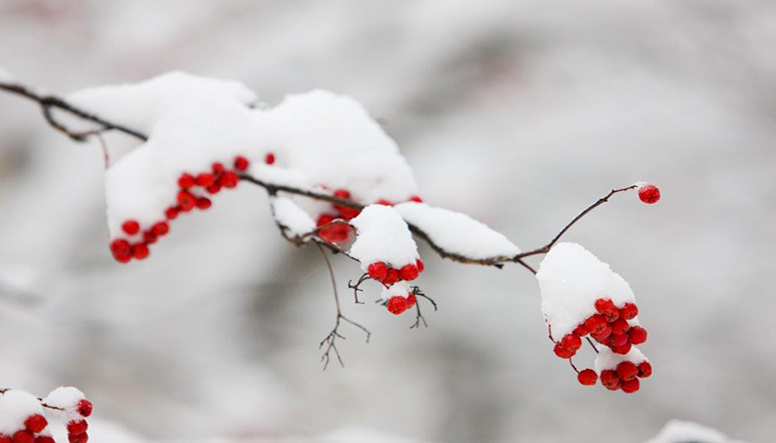A SEASONAL GUIDE: WINTER LAWN AND LANDSCAPE CARE
Protect your plants and trees from the cold and ice
For trusted expertise and superior results,
find a landscape professional near you.

When the north winds start to blow and flakes dance in the air, the only tree many people think of is the one they decorate with tinsel and twinkling lights. However, the trees outside your window need attention at this time of year as well. Trees, like all living things, need protection from winter’s advances as the harsh conditions can cause them significant damage.
Common Winter Tree Dangers and How to Avoid Them
Sun Scald – As long as their dormant tissue remains dormant, trees are unlikely to suffer damage from cold. However, when a young tree’s bark is exposed to strong sunlight, it can warm the tissue enough to trigger localized activity. Then, when night falls and temperatures drop, the non-dormant tissue freezes, active cells are killed and tree damage results.
Sun scald appears as patches of dead and/or cracked bark, usually on the south or south west side of the tree. Young trees are most vulnerable because their thin bark is less resistant to changes in temperature. The damage is unsightly and can make the tree more susceptible to disease and insect predation once warm weather comes.
The best way to protect your trees from sun scald is to protect them from winter sun exposure. This includes both direct exposure and sunlight reflected off snow. Orchard managers often paint tree trunks with white latex paint to reflect the light and keep the bark cool. However, you may not care for white trunks on your ornamental and shade trees! Instead, you can wrap the trunk for the winter with removable light-colored tree wrap, or create shade with a temporary fence, or by leaning a board against the south side of the tree for the winter.
Foliar Damage to Evergreens – The same phenomenon that causes sun scald can also damage the leaves of evergreen trees and shrubs. Evergreen foliage can suffer desiccation damage from exposure to cold winter winds or from a failure to harden off completely before a sudden temperature drop in the fall. Newly planted evergreens are most likely to be affected.
Keep your arbor vitae and other evergreens nicely green by wrapping them with burlap or shrub wrap, especially on the south and southwest sides. Temporary screens and wind barriers can also help. You can apply an anti-transpirant, or anti-dessicant, to evergreen foliage a couple times during the cold season to prevent moisture loss from the leaves or needles. Finally, be sure to water the roots of your evergreens deeply in the fall to help leaf and needle tissues stay hydrated throughout the winter.
Root Damage - Tree roots don’t like severe cold. When soil temperatures dip below about 15˚, many roots will suffer damage or even die. To keep roots cozy, water well in the fall because moist soil holds heat better than dry soil. It’s also a very good idea to mulch your trees for the winter, especially young and shallow-rooted ones. A 2-4” layer of mulch under new trees and shrubs will help insulate the ground as well as prevent frost heaving, which can expose roots to cold air. Keep the mulch away from the trunk, though, to prevent it becoming a haven for mice.
Mechanical Damage from Ice & Snow - Wet snow and ice are quite heavy and can bend and break tree branches. After a heavy snow, gently shake or knock excess snow from the branches of your trees before it freezes in hard clumps that the wind can easily catch. (Don’t try to liberate them if they’re encased in ice, though – it won’t shake loose on its own and you could damage them trying.) For especially vulnerable species such as evergreen shrubs, tying up the branches loosely for the winter can help prevent damage.
Animal Damage - Bambi and Thumper look-a-likes may be cute to watch frolicking in the snow, but when they’re done playing, they get hungry – and few things are more tasty or available to wildlife in winter than the twigs and bark of young trees!
Deer, in particular, are the scourge of suburban landscapes. They are large and bold, and can inflict a lot of damage fast. Keeping them away from your trees can be a frustrating task. Try anti-deer fencing, motion activated lights and/or repellents. They don’t like the smell of blood, so dipping strips of cloth in a blood meal solution and hanging them in your tree branches can be effective. If deer are plentiful in your area, consider sticking to deer-resistant tree species such as holly, vibernum and spruce.
Rabbits and rodents love to gnaw on the tender bark of young trees and can easily girdle a tree in a single night. Protect trunks of young trees with tree guards or wraps available at your local nursery. Or, wrap each trunk with ¼” hardware cloth to at least 18” above your anticipated snow line. Be sure to remove trunk wrappings in the spring so they don’t damage the trees.
Winter Tree Damage Prevention Tips
Here are a few general rules of thumb to help keep your trees healthy throughout the winter:
Proper winter tree care depends a lot on location and species. While these tips are a good general starting point, nothing beats local experience. If you want to give your trees the very best winter care possible, consult a landscape professional in your area who is well versed in tree and shrub care. It’s a gift to your trees that will keep on giving for years to come!
We recently updated our Privacy Policy. By continuing to use this website, you acknowledge that our revised Privacy Policy applies.